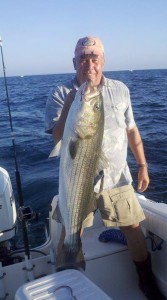“Holy cow I think I have a tuna!” I yelled to my father, who was out cold, asleep in the cabin. Line was screaming off my light spinning setup as my Dad struggled to raise his newly retired, and half asleep self to his feet. I was doing my best to avoid the other lines I had set off the stern, which by now, were also doubled over, with braid hissing off the reels. A quick glance at the sonar revealed what was going on beneath our boat-after a long slow night we had officially hit the mother load.
Over the next 45 minutes my father and I fell into an awesome routine. As quickly as we could get a bass unhooked, and an eel or tube n’ worm back in the water, we were hooked up again. It was one of those moments during the season that create the nostalgic memories that help get a fisherman through the winter. By the end of the pandemonium we had landed 15 bass between 20-40 pounds. Less than an hour ago my father had been sound asleep, but now he was sweating profusely. What a wonderful scene!

If you told me this story ten years ago I never would have believed you. We used to troll around aimlessly for hours, hoping and praying for one or two nice bass. Finding any consistent number of fish in Cape Cod Bay, or any large expanse of water for that matter, seemed overwhelming and intimidating. I used to often times hope there would be a fleet of boats out there somewhere to help us at least get an idea of where there may be some fish. That was until we developed a consistent strategy for finding bass, determining their behavior one we found them, and then matching their behavior with a technique that will put bass in the boat.
So why not spread the wealth? To be completely honest, any fish my father and I catch these days is really just a culmination of the generous information shared with us from anglers we’ve met in the past. Their generosity, coupled with reading many articles of “On The Water,” and a lot of trial and error, is really what’s led to us hooking up with just about any fish we’re fortunate enough to tie in to. I think it is pretty much impossible to completely figure out striped bass-especially if you spend your time fishing in areas where there is no dramatic current or structure to hold fish. A proven strategy that you can employ each time you leave the dock is in my opinion, the best way to consistently create successful trips.
Locating the Fish
I sometimes become overwhelmed by the vastness of Cape Cod Bay, where we do most of our fishing. How the heck am I supposed to find a fish amongst these 600 square miles of saltwater? There really is no significant amount of structure or tidal flow when contrasted with places like the Elizabeth Islands, Buzzards Bay, Nantucket or the Vineyard. And rare are the days that the birds will lead you to the fish, especially during the height of summer when the bass hold deep. Unless you have a spotter plane, or military sonar, there’s really no easy answer. But putting 100% trust into the sonar you do have, and covering a lot of water, will certainly put your boat on the right track.
In order to develop a strategy for your area it makes sense to consider wind direction. Where we fish the wind is usually blowing from a westerly direction. So it makes sense for us to search for fish in a west to east fashion. This way we don’t beat ourselves up pounding the boat into the waves. I’ll just pick a depth that’s been productive in the past and start heading east at around 15 knots. This way the boat’s moving at a decent clip, and we can still distinguish bass marks on the finder. We’re not getting beat up because we have the breeze at our stern, and moving in a straight line will allow us to estimate how much life is in a given stretch of water-which we’ll talk about more later. (So in other words while we choose to move in a west to east fashion, it is important for you to determine a direction that works best for the area you fish. For the sake of simplicity I will use our west to east direction to help you better grasp the message I’m trying to send).
While heading east keep a trained eye on your sonar. You don’t need any special sonar, however a color fish finder in which you can put 100% faith in is extremely important. As soon as we see that wonderful orange blotch (which is undoubtedly a bass on our Lowrance sonar) the lines immediately go into the water.

Many less experience anglers underplay the importance of marking even just one solid bass on the sonar. However, marking even just one solitary bass on the sonar is a fantastic sign if you put some thought into it. What’re the odds of that one fish on your sonar being the only bass in the area? In open water areas it’s not uncommon for us to search for 10 miles or more without marking a single striped bass. More often than not that one fish you marked is but one of hundreds of nice bass in the area. Pat yourself on the back because you’ve just won half the battle.
Even if we’ve marked much more than one bass my main concern will not be to whip the boat around and locate that same school of fish. Instead, I’m putting my money on there being many more fish in this area than what I’ve only seen on my sonar. You are in all honesty, putting one little hook into a giant ocean and expecting a nice bass to find it. You need to find an area with a ton of fish in it in order to produce a successful trip. And the best way to do that is to work on establishing a repeatable pattern for the trip instead of chasing around one school or mark on the sonar.
So with that said as soon as we see any bass marks on the sonar the tube n’ worms will go into the water, and we’ll begin to troll eastward. Even if I intend on fishing live eels we almost always begin our trips with the tube n’ worm. We will always start trolling the tube n’ worm simply because we seem to have an easier time putting fish in the boat with it(because of bite-to-hook up ratios etc.)granted of course the bass are interested in eating the tube.
Once we get our troll established, we’ll use the “15 minute rule of thumb” to our advantage. The “15 minute rule of thumb” will be discussed in greater depth later in the article, as it relates to determining striped bass behavior. However I’ve described below how the “15 minute rule of thumb,” when combined with moving in a consistent west to east direction, helps us to in accomplishing the following:
Determine the amount of bass hanging in a given stretch of water
Say for example we’ve caught a few bass and made a successful troll east but now have gone 15 minutes without another hit or mark on the sonar. It’s time to cruise back west to where the action began. Using our sonar we can determine on the cruise back, just how many fish have moved into the area we just trolled through. Maybe we mark more fish on the cruise back west than we did during our initial troll east. This tells me that more fish have moved into the area. Or, if we have less marks or no marks at all, it tells me that the fish are on the move.
Increase our odds of staying with the bass
Say we’ve made a successful troll east and have gone our 15 minutes without a bite or mark on the sonar. On the cruise back west we notice that we are not marking as many fish as we did during our most recent successful troll. Well that can only mean one thing-the fish are on the move. We do notice however that we start marking fish more consistently the closer we approach our westward starting point. This can only mean one thing-the fish are on the move west. We can either continue to cruise west, past our old troll’s starting point to see if our hunch is correct, or put lines in and instead of repeating our previous eastward troll, switch directions and troll west with the general movement of the fish.
Establish a repeatable pattern
If we trolled in random directions or circles it would be difficult to establish a repeatable pattern. On some trips we’ve spent an entire 8 hours making the same west to east troll, because the fish never left the area. On the other hand we’ve watched as other boats occasionally circle past, and then continue off into the distance, leaving behind the mother load of bass.
Of course there are no guarantees and sometimes we’ll completely lose the fish despite our most calculated boat movements. But since adopting this system we have dramatically improved our results. Many times we have been fortunate enough to establish a half mile or so stretch of water that held fish, and have been able to repeat the same troll for an entire trip. Other times we have come upon a large amount of fish that continue to move eastward, the same direction as our troll, and we’ve spent an entire trip continually heading east. On a few trips we’ve even trolled as far as 6 miles, with consistent action the entire way. And of course we’ve also had trips where despite our best efforts, we’ve been skunked!
Tight lines and good luck sticking with the biomass!
Captain Ryan
